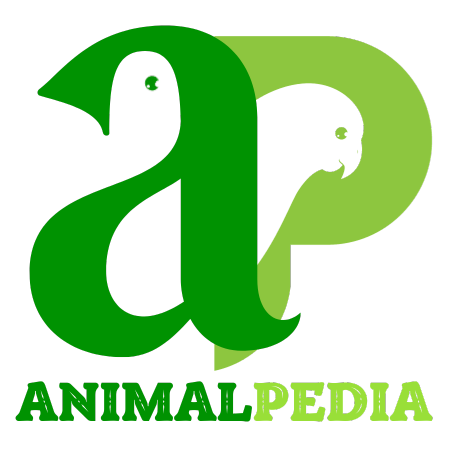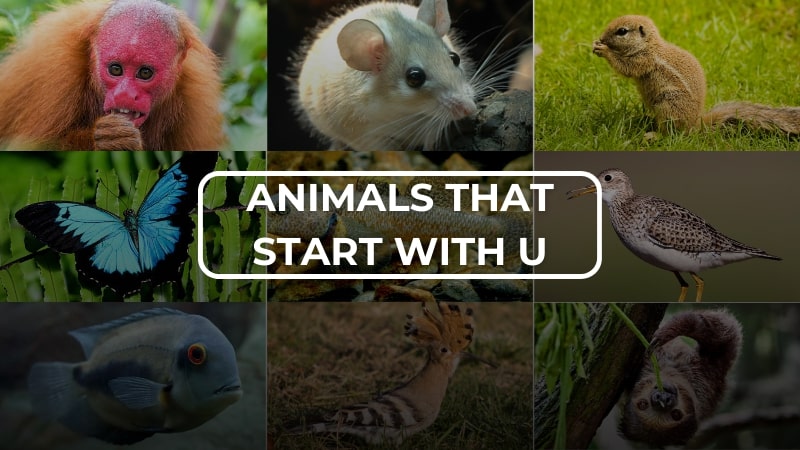Most Popular Animal Start with U
The animal world never ceases to amaze, and exploring its members is always a delight. Today, we’re shining a light on fascinating creatures whose names begin with the letter ‘U.’ From the endearing Umbrellabird to the agile Uinta ground squirrel, these animals showcase the rich diversity of life on Earth.
Whether you’re a curious student looking to expand your knowledge, an animal enthusiast seeking fresh facts, or just here for some fun discoveries, this selection of animals starting with ‘U’ will captivate and expand your appreciation for nature’s wonders!
| Umbonia spinosa | Umbrella octopus | Unicornfish |
| Urocyon | Uganda Kob | Urial |
| Urchins | Umbrellabird | Uakari |
| Unio crassus |
1. Umbonia spinosa
The Thorn Bug (Umbonia spinosa) is a fascinating member of the treehopper family (Membracidae), native to Central and South America and extending into parts of southern North America. These tiny insects measure only 0.4–0.6 inches (1–1.5 cm) and are brightly colored in green, yellow, or brown with dark markings for camouflage. Their most striking feature is the sharp, spine-like projection on their thorax, resembling a plant thorn, which helps deter predators by mimicking natural vegetation.
Thorn bugs feed on plant sap, using their piercing-sucking mouthparts to extract nutrients from stems and branches. Active during the day, they are often found in small groups on their host plants. Females display maternal care, guarding their eggs and young nymphs and guiding them to feeding sites.
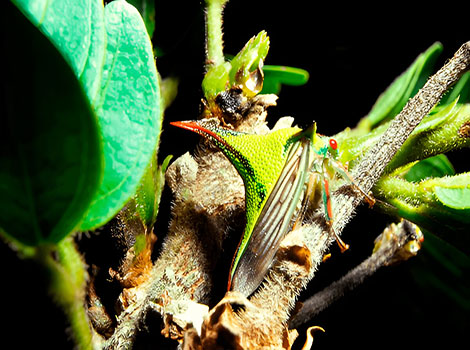
| Attributes | Quick facts |
|---|---|
| Size | ~0.5 inches (1–1.5 cm) |
| Weight | Very lightweight, a few milligrams |
| Lifespan | A few months to 1 year |
| Habitat | Tropical and subtropical regions, often on host plants like acacia trees |
| Diet | Plant sap (phloem) extracted through piercing host plants |
| Social Structure | Often found in small groups, with maternal care observed |
| Conservation | Not Evaluated |
Fun fact: These insects not only contribute to the biodiversity of their ecosystems but also showcase incredible mimicry that often deceives both predators and humans!
2. Umbrella octopus
The Umbrella Octopus, part of the genus Opisthoteuthis and family Opisthoteuthidae, is a remarkable deep-sea creature found in the Atlantic, Pacific, and Indian Oceans. These octopuses inhabit cold, high-pressure depths ranging from 500 to 4,000 meters (1,640–13,100 feet). With a soft, gelatinous body and a round mantle, they display reddish or orange hues, sometimes with bioluminescent features. Their arms are connected by a web of skin, resembling an open umbrella, a unique adaptation for movement and capturing prey.
They are slow-moving carnivores, using their webbed arms to envelop small crustaceans, worms, and zooplankton. Propelled by small fins or jet propulsion, they navigate the dark ocean. Umbrella Octopuses are solitary, conserving energy in food-scarce environments. Females show exceptional care by guarding and aerating their eggs for months or years, sacrificing their lives to ensure the young survive. Hatchlings are independent and resemble miniature adults from birth.
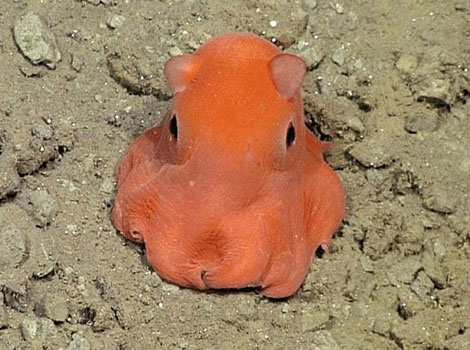
| Attributes | Quick facts |
|---|---|
| Size | 8–12 inches (20–30 cm) |
| Weight | Up to 11 lbs (5 kg) |
| Lifespan | Estimated 3–5 years |
| Habitat | Deep ocean waters, found at depths of 500–6,000 feet (150–1,800 meters) |
| Diet | Small fish, crustaceans, and plankton |
| Social Structure | Solitary |
| Conservation | Not Evaluated |
Fun fact: These octopuses are part of the same group as the charming Dumbo Octopus, making them fascinating denizens of the deep!
3. Unicornfish
Unicornfish, belonging to the genus Naso in the Acanthuridae family, are fascinating inhabitants of coral reefs and coastal areas in the Indo-Pacific, including the Red Sea and Pacific Ocean. These slender, elongated fish grow 18–24 inches (45–60 cm) long, with some species reaching up to 39 inches (1 meter). Their most striking feature is the horn-like projection on the forehead, seen in adults of certain species like the Bluespine Unicornfish (Naso unicornis).
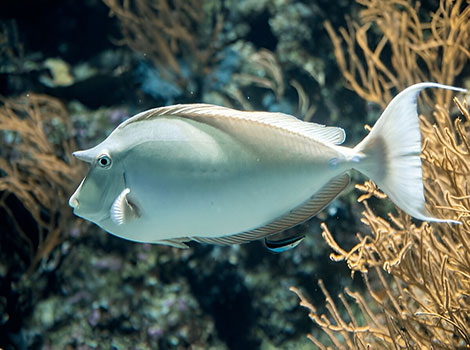
| Attributes | Quick facts |
|---|---|
| Size | 12–27 inches (30–70 cm) |
| Weight | Up to 10 lbs (4.5 kg) |
| Lifespan | Estimated 10–20 years |
| Habitat | Coral reefs and coastal waters of the Indo-Pacific region |
| Diet | Algae and plankton |
| Social Structure | Found in schools, especially as juveniles |
| Conservation | Least Concern |
Fun fact: Their horn has no known defensive or functional purpose, making it a mystery to scientists!
4. Urocyon
The Gray Fox (Genus Urocyon), including the Common Gray Fox (Urocyon cinereoargenteus) and the Island Fox (Urocyon littoralis), belongs to the Canidae family. They are medium-sized canids found in diverse habitats such as forests, scrublands, grasslands, and even urban areas. While U. cinereoargenteus ranges from southern Canada to northern South America, U. littoralis is limited to California’s Channel Islands.
Gray Foxes are 31–44 inches (79–112 cm) long, with males weighing 8–15 pounds (3.6–6.8 kg). Their thick fur is gray, accented with black and reddish-brown, and a bushy tail with a black tip. Remarkably, they can climb trees thanks to their strong claws, a rare skill among canids. Gray foxes are omnivorous, eating rodents, berries, and insects, and adapt their diet to the seasons. During late winter, they breed and raise 3–7 pups, with both parents involved. These foxes are nocturnal, territorial, and use trees to escape predators or rest.
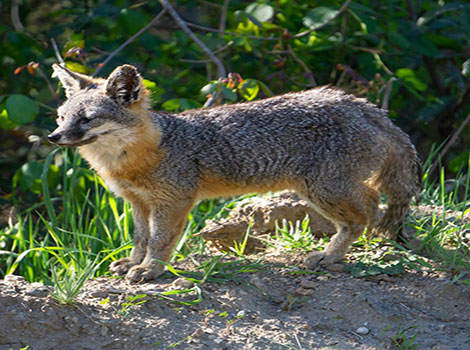
| Attributes | Quick facts |
|---|---|
| Size | 18–27 inches (45–68 cm), with a tail of 11–16 inches (28–41 cm) |
| Weight | 5–15 lbs (2.3–7 kg) |
| Lifespan | 6–10 years in the wild, up to 15 years in captivity |
| Habitat | Forests, woodlands, and scrublands in North and Central America |
| Diet | Omnivorous – fruits, insects, small mammals, and birds |
| Social Structure | olitary, occasionally forming family units |
| Conservation | Least Concern |
Fun Fact: Gray foxes are one of the oldest living canids, with a lineage dating back millions of years! Their ability to climb trees makes them truly unique in their family.
5. Uganda Kob
The Ugandan Kob (Kobus kob thomasi), a subspecies of the Kob, is a graceful antelope belonging to the Bovidae family. Native to Uganda, they are commonly found in Queen Elizabeth and Murchison Falls National Parks, as well as parts of South Sudan and the Democratic Republic of Congo. These animals thrive in warm, tropical climates, living in open grasslands and floodplains near water sources.
With a reddish-brown coat and white patches on the throat and underbelly, males are darker and possess long, spirally twisted horns up to 20 inches (50 cm). Their slender, muscular build aids in running and leaping to evade predators. Ugandan Kobs are herbivores, grazing on grasses and plants, primarily in cooler parts of the day. They form distinct social groups: harems, bachelor herds, and female herds. Breeding peaks during rainy seasons, and females give birth to single calves, hiding them in tall grass before they join the herd.
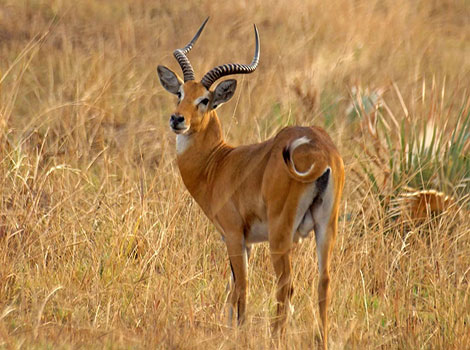
| Attributes | Quick facts |
|---|---|
| Size | 28–33 inches (70–85 cm) at the shoulder |
| Weight | 200–240 lbs (90–110 kg) |
| Lifespan | 15–20 years |
| Habitat | Grasslands, wetlands, and savannas in East Africa, particularly Uganda |
| Diet | Grasses and other low-lying vegetation |
| Social Structure | Found in herds, with males forming territorial groups |
| Conservation | Least Concern |
Fun fact:
These antelopes engage in a unique mating system known as “lekking,” where males gather in a communal area called a lek to compete for the attention of females.
6. Urial
The Urial, scientifically known as Ovis vignei, is a wild sheep belonging to the Bovidae family. These animals are native to Central and South Asia, inhabiting grassy slopes, rocky hills, and scrublands in countries like Pakistan, Iran, and Afghanistan. Males stand out with their large, spiraling horns that can grow up to 40 inches (100 cm), while females have shorter, straighter horns. They have reddish-brown coats that lighten in winter, with males sporting a black “mane” along their neck and chest.
Urials are herbivores, grazing on grasses and shrubs during cooler parts of the day. They are well adapted to rugged terrain, using their long legs to climb steep slopes and avoid predators. Males often live alone or in bachelor groups, joining female herds only during autumn mating season. After five months, females give birth to 1–2 lambs in spring, nursing them until they can join the herd.
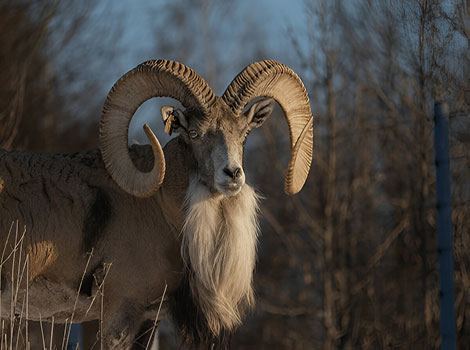
| Attributes | Quick facts |
|---|---|
| Size | 31–35 inches (79–90 cm) at the shoulder |
| Weight | 85–200 lbs (40–90 kg) |
| Lifespan | 10–13 years |
| Habitat | Grasslands, scrublands, and rocky terrain of Central and South Asia |
| Diet | Grasses, shrubs, and herbs |
| Social Structure | Found in herds, typically segregated by gender outside mating season |
| Conservation | Near Threatened |
Fun fact:
Urials are known for their social nature, typically found in herds that can range from a few individuals to over a hundred.
7. Urchins
Sea Urchins, belonging to the class Echinoidea, are spiny marine creatures found globally, from icy polar waters to warm tropical seas. They inhabit shallow coastal areas, coral reefs, rocky shores, and seagrass beds, with some species venturing into deeper waters. Typically measuring 1–4 inches (2.5–10 cm) in diameter, their rigid, spiny shells (tests) come in vibrant colors such as purple, red, green, or black.
These slow-moving creatures use their movable spines and tube feet for protection, burrowing, and crawling. Sea urchins primarily feed on algae and kelp, using a specialized mouthpart called “Aristotle’s lantern” to scrape food from surfaces. They are mostly nocturnal, avoiding predators like fish, sea otters, and crabs. Reproduction involves releasing eggs and sperm into the water for external fertilization. The free-swimming larvae eventually settle and transform into juvenile urchins.
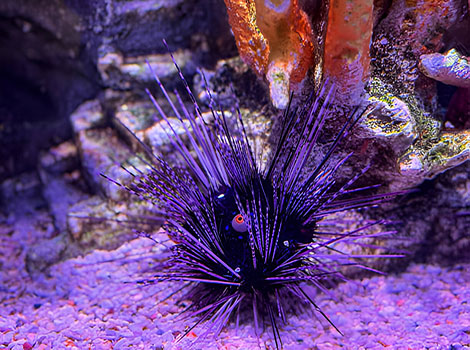
| Attributes | Quick facts |
|---|---|
| Size | 1–14 inches (2.5–35 cm) |
| Weight | A few ounces to several pounds |
| Lifespan | 5–100+ years |
| Habitat | Ocean floors worldwide |
| Diet | Algae and organic matter |
| Social Structure | Solitary or grouped |
| Conservation | Near Threatened |
Fun Fact: Sea urchins help control algae in marine ecosystems, but species like the Purple Sea Urchin can overpopulate, threatening kelp forests. They can also regenerate damaged body parts, a remarkable evolutionary trait!
8. Umbrellabird
The Umbrellabird is a fascinating bird belonging to the Cotingidae family, with species such as the Long-wattled and Amazonian Umbrellabird. These birds are native to Central and South America, thriving in the warm, humid climates of tropical and subtropical rainforests. Measuring 14–20 inches (36–51 cm) and weighing 12–16 ounces (340–450 grams), they have striking black plumage with a glossy sheen.
Male Umbrellabirds are known for their unique umbrella-shaped crest and, in some species, a long throat wattle used in courtship displays. They are omnivores, feeding on fruits, insects, and small animals. While mostly solitary, males gather in small groups during elaborate courtship displays, where they raise their crests, inflate their wattles, and produce booming calls. Females take sole responsibility for building nests, incubating 1–2 eggs, and raising the chicks high in the trees. These remarkable behaviors make the Umbrellabird a true marvel of the rainforest!
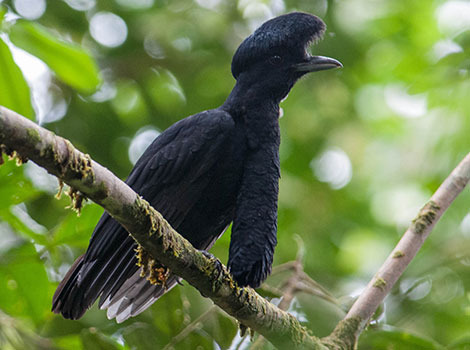
| Attributes | Quick facts |
|---|---|
| Size | 14–20 inches (35–51 cm) |
| Weight | 12–16 oz (340–450 grams) |
| Lifespan | Estimated 10–20 years |
| Habitat | Tropical rainforests of Central and South America |
| Diet | Fruits, insects, and small vertebrates |
| Social Structure | Solitary, occasionally in small groups |
| Conservation | Vulnerable |
Fun fact:
The diet of the Umbrellabird primarily consists of fruits, making them important seed dispersers in their ecosystem.
9. Uakari
The Uakari, belonging to the genus Cacajao and the Pitheciidae family, is a unique monkey found in the Amazon Basin, including Brazil, Peru, and Colombia. These primates are known for their striking appearance, with Bald Uakaris featuring bright red, hairless faces and shaggy, reddish or golden brown fur. Unlike most monkeys, their short, non-prehensile tails measure only 6–7 inches (15–18 cm).
Adapted for life in the treetops, Uakaris thrive in tropical, humid environments near rivers and wetlands. Agile climbers, they leap between branches, rarely coming to the ground. They primarily eat hard, unripe fruits, using strong jaws to crack tough shells, but also consume seeds, leaves, and insects. Living in groups of 10–30, sometimes forming larger troops, they are social and active during the day. Females give birth to one infant after a 6-month gestation, with mothers and the group offering protection and care.
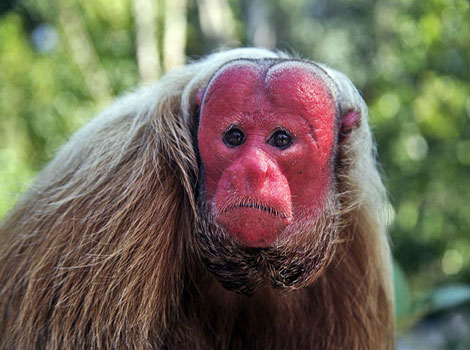
| Attributes | Quick facts |
|---|---|
| Size | 14–22 inches (35–55 cm), with a tail length of 5–6 inches (15–18 cm) |
| Weight | 4.4–7.7 lbs (2–3.5 kg) |
| Lifespan | 15–20 years |
| Habitat | Flooded forests and swampy areas of the Amazon Basin |
| Diet | Fruits, seeds, leaves, and insects |
| Social Structure | Live in groups of 10–30 individuals |
| Conservation | Vulnerable |
Fun fact:
The redder the face, the healthier the monkey – in Uakaris, facial coloration is a key indicator of health and attractiveness to mates.
10. Unio crassus
The Thick-Shelled River Mussel (Unio crassus) is a fascinating freshwater bivalve belonging to the Unionidae family. Found in clean rivers and streams across Europe and parts of western Asia, these mussels thrive in well-oxygenated waters with sandy or gravelly bottoms. They are typically 2.5–4 inches (6–10 cm) long, with thick, oval shells that are dark brown to black, often with a greenish tint in younger individuals.
As filter feeders, they draw water through their siphons, filtering out plankton and organic particles, which helps purify their aquatic habitats. Sedentary by nature, they spend most of their lives partially buried in sediment, contributing significantly to water quality. Reproduction involves males releasing sperm into the water, which females draw in to fertilize eggs. The larvae, called glochidia, attach to host fish like trout or salmon to develop.
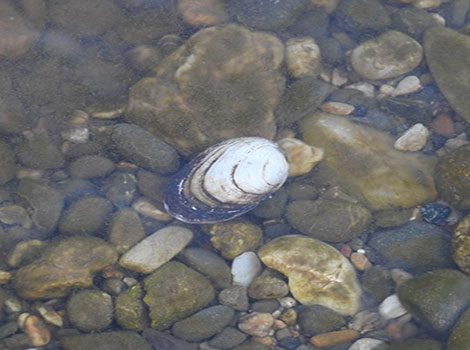
| Attributes | Quick facts |
|---|---|
| Size | 4–6 inches (10–15 cm) |
| Weight | 1–2 oz (30–60 grams) |
| Lifespan | Estimated 1–2 years |
| Habitat | Forested regions of the Ucayali River Basin, Peru |
| Diet | Seeds, fruits, and insects |
| Social Structure | Solitary or small groups |
| Conservation | Not Evaluated |
Fun Fact: The Thick-Shelled River Mussel is a key indicator of water quality and can live for decades if its habitat remains pristine!
As we dive deeper into the fascinating world of animals that start with ‘U,’ let’s begin by exploring the mammals. These warm-blooded creatures captivate us with their unique adaptations and behaviors, offering a closer look at the incredible diversity within this class.
Mammals that start with U
Unveiling the world of mammals, let’s delve into those whose names begin with the letter ‘U,’ revealing unique traits and fascinating stories that highlight the diversity of this remarkable class of animals.
| Ucayali Spiny Mouse | Underwing Moth | Uinta Chipmunk |
| Uzbekistan Vole | Unau (Linnaeus’s Two-Toed Sloth) | Underwood’s Long-Tongued Bat |
| Uinta Ground Squirrel | Unstriped Ground Squirrel | Utah Prairie Dog |
| Unadorned Rock Wallaby | Usambara Shrew |
11. Ucayali Spiny Mouse
The Ucayali Spiny Mouse, scientifically called Scolomys ucayalensis, is a small rodent native to the rainforests near Peru’s Ucayali River. These mice are tiny, measuring 4–5 inches (10–13 cm) and weighing just 1–1.5 ounces (28–43 g). They thrive in warm, humid tropical climates and are non-migratory, staying in their forest homes. Their brownish-gray fur is spiny on top, offering protection, while the softer fur on their belly adds contrast. They have a rounded body, a scaly tail, and spiky fur that deters predators.
Nocturnal creatures, Ucayali Spiny Mice forage at night for seeds, fruits, and small insects on the forest floor. They breed several times a year, with females giving birth to 2–5 young per litter and caring for them in hidden nests.
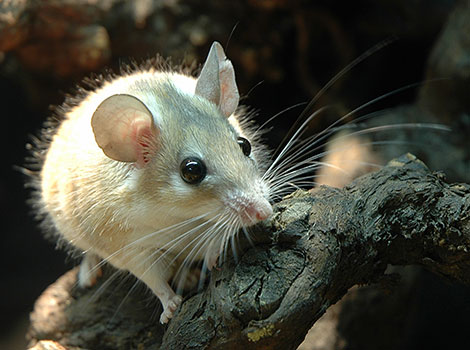
| Attributes | Quick facts |
|---|---|
| Size | 4–6 inches (10–15 cm) |
| Weight | 1–2 oz (30–60 grams) |
| Lifespan | Estimated 1–2 years |
| Habitat | Forested regions of the Ucayali River Basin, Peru |
| Diet | Seeds, fruits, and insects |
| Social Structure | Solitary or small groups |
| Conservation | Not Evaluated |
Fun fact: their spiky fur isn’t just for show—it makes them harder for predators to grab!
12. Underwing Moth
The Underwing Moth, part of the genus Catocala, is known for its unique defense mechanism. The upper side of its wings is drab and blends with tree bark, while the underwings are brightly colored. The hindwings, usually hidden, are brightly colored with reds, oranges, or yellows and black bands. Underwing Moths typically have a wingspan of 5–10 cm (2–4 inches) and weigh approximately 1–2 grams (0.04–0.07 ounces). They are found in wooded areas and forests across North America and Europe.
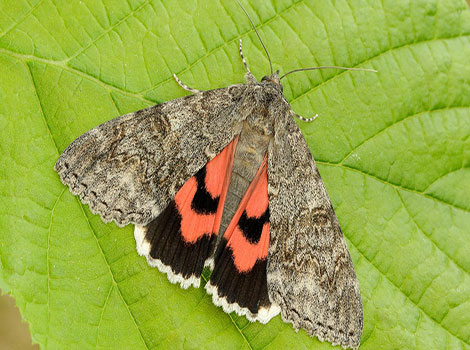
| Attributes | Quick facts |
|---|---|
| Size | Wingspan 1.5–3.5 inches (4–9 cm) |
| Weight | A few grams |
| Lifespan | A few weeks to months (adult stage) |
| Habitat | Forests, woodlands, and gardens worldwide |
| Diet | Nectar (adults), leaves (larvae) |
| Social Structure | Solitary |
| Conservation | Not Evaluated |
Fun fact: When threatened, the Underwing Moth reveals its vibrant underwings, startling predators and giving them a chance to escape.
13. Uinta Chipmunk
The Uinta Chipmunk, scientifically known as Neotamias umbrinus, is a small rodent belonging to the squirrel family. Found in montane forests of the western United States, it prefers cooler, mountainous climates and often moves to lower elevations during winter. These chipmunks are about 8–11 inches long (20–28 cm), including their bushy tails of 3–5 inches (8–12 cm). Weighing only 1.5–2.5 ounces (42–70 g), they are slender-bodied with reddish-brown or grayish-brown fur marked by five dark stripes on their backs.
Uinta Chipmunks are diurnal and forage for nuts, seeds, berries, fungi, and small insects, storing extra food in burrows or tree hollows for winter. They are territorial, vocal, and solitary, often chattering to alert others of predators. Each spring, females give birth to 4–6 pups, raising them in underground nests.
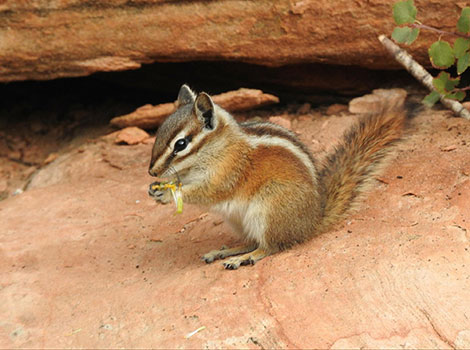
| Attributes | Quick facts |
|---|---|
| Size | 8–10 inches (20–25 cm) |
| Weight | 1.5–2.5 oz (40–70 grams) |
| Lifespan | 2–4 years in the wild |
| Habitat | Coniferous forests and rocky areas in the western United States |
| Diet | Seeds, berries, insects, and nuts |
| Social Structure | Solitary |
| Conservation | Least Concern |
Fun fact: The Uinta Chipmunk can carry an incredible amount of food in its cheek pouches—up to three times the size of its head! This helps them transport food efficiently to their storage sites.
14. Uzbekistan Vole
The Uzbekistan Vole, scientifically named Microtus juldaschi, is a small rodent from the Cricetidae family, which includes hamsters and lemmings. It inhabits steppe regions, grasslands, and areas near agricultural fields in Uzbekistan and neighboring regions. Adapted to arid and semi-arid climates, these voles endure hot summers and cold winters without migrating. Measuring 4–5 inches (10–13 cm) in body length, with a 1–2-inch (2.5–5 cm) tail, they weigh about 1.5–2.5 ounces (42–70 g). Their brownish-gray fur, rounded head, and small ears help them blend into their grassland environment.
Uzbekistan Voles are crepuscular, foraging for grasses, seeds, roots, and sometimes crops during dawn and dusk. They are social animals, living in colonies with intricate burrow systems, where they store food for winter. Females produce litters of 4–8 pups several times a year, raising them in burrows until independence.
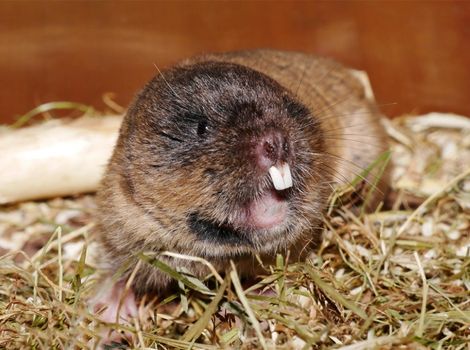
| Attributes | Quick facts |
|---|---|
| Size | 4–5 inches (10–13 cm) |
| Weight | 1–2 oz (30–60 grams) |
| Lifespan | 1–2 years |
| Habitat | Grasslands and steppes of Central Asia, particularly Uzbekistan |
| Diet | Grasses, seeds, and roots |
| Social Structure | Colonial or small family groups |
| Conservation | Least Concern |
Fun fact: The Uzbekistan Vole is a natural soil aerator! Its burrowing activities help improve soil quality and promote plant growth in its ecosystem.
15. Unau (Linnaeus’s Two-Toed Sloth)
The Unau, or Linnaeus’s Two-Toed Sloth (Choloepus didactylus), is a slow-moving mammal from the Megalonychidae family. Found in the tropical rainforests of northern South America, including Venezuela, Brazil, and Colombia, these sloths prefer the safety of high tree canopies in warm, humid climates. Measuring 21–29 inches (53–74 cm) and weighing 11–20 pounds (5–9 kg), they are known for their long, coarse fur that often appears green due to algae growth, helping them blend into their surroundings.
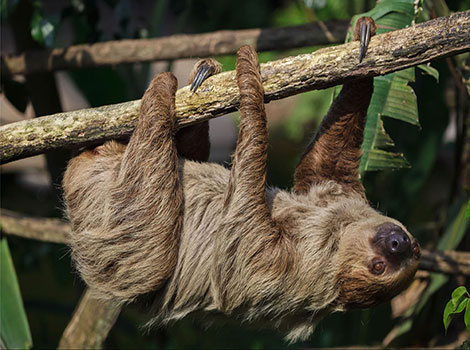
| Attributes | Quick facts |
|---|---|
| Size | 21–29 inches (53–74 cm) |
| Weight | 8–19 lbs (3.6–8.6 kg) |
| Lifespan | 20–30 years |
| Habitat | Tropical rainforests of South America |
| Diet | Leaves, fruits, and flowers |
| Social Structure | Solitary |
| Conservation | Least Concern |
Fun Fact: Unaus give birth to a single baby after a 10-month pregnancy. The young cling to their mother’s belly for months, learning survival skills until they are ready to live independently!
16. Underwood’s Long-Tongued Bat
The Underwood’s Long-Tongued Bat (Hylonycteris underwoodi), a member of the Phyllostomidae family, is a tiny yet remarkable bat native to Central America, including Mexico, Guatemala, and Costa Rica. These bats inhabit warm, humid tropical and subtropical forests, often near flowering plants. Measuring 2–3 inches (5–7.5 cm) in length with a wingspan of 10–11 inches (25–28 cm), they weigh just 0.3–0.4 ounces (8–12 grams).
Known for its incredibly long tongue, which exceeds its body length when extended, this bat is perfectly adapted for feeding on nectar deep within flowers. Its soft fur varies from grayish-brown to reddish-brown, and its small, leaf-shaped nose helps with echolocation. As nocturnal foragers, these bats play a critical role as pollinators for tropical plants, including cacti and agaves.
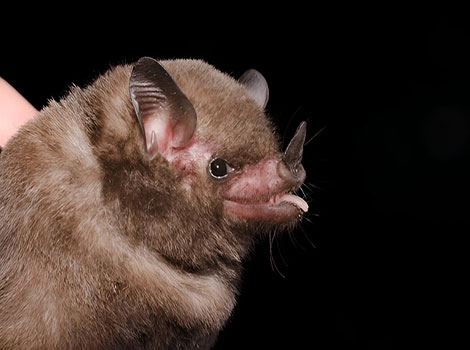
| Attributes | Quick facts |
|---|---|
| Size | 2–3 inches (5–8 cm) |
| Weight | 0.2–0.4 oz (6–12 grams) |
| Lifespan | Estimated 5–10 years |
| Habitat | Tropical forests and deserts in Central America |
| Diet | Nectar, pollen, and fruits |
| Social Structure | Small colonies |
| Conservation | Least Concern |
Fun Fact: Underwood’s Long-Tongued Bat is one of nature’s most specialized pollinators, relying on its extreme tongue length to sustain itself while supporting biodiversity in its ecosystem!
17. Uinta Ground Squirrel
The Uinta Ground Squirrel (Urocitellus armatus), part of the Sciuridae family, is a small burrowing rodent native to the western United States, especially in Utah, Idaho, Montana, and Wyoming. Often spotted in Yellowstone National Park, they inhabit open meadows, grasslands, and sagebrush flats at elevations of 6,000–10,000 feet (1,800–3,000 meters). Measuring 9–12 inches (23–30 cm) in length, including their 2–4-inch (5–10 cm) bushy tail, these squirrels weigh between 6–11 ounces (170–310 grams).
Their light brown or grayish-brown fur, with subtle mottling, provides effective camouflage. Uinta Ground Squirrels are omnivorous, feeding on grasses, seeds, flowers, and insects. They are active during daylight, foraging near their burrows in early morning and late afternoon. Social yet loosely organized, they live in colonies and hibernate for 8–9 months annually.
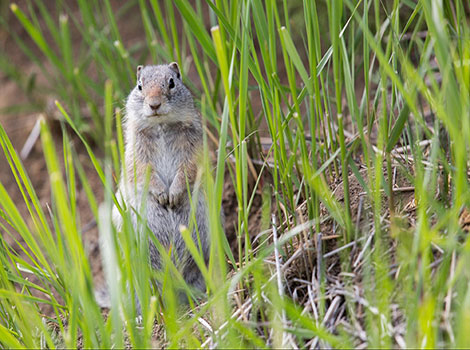
| Attributes | Quick facts |
|---|---|
| Size | 11–12 inches (28–30 cm) |
| Weight | 6–11 oz (170–310 grams) |
| Lifespan | 3–4 years in the wild |
| Habitat | Meadows and grasslands in the western United States |
| Diet | Grasses, seeds, insects, and small plants |
| Social Structure | Colonial, with complex burrow systems |
| Conservation | Least Concern |
Fun Fact: Nicknamed “chiselers” for their chipping calls, Uinta Ground Squirrels aerate soil with their burrows and are an essential prey species for predators like hawks and foxes!
18. Unstriped Ground Squirrel
The Unstriped Ground Squirrel (Xerus rutilus), a member of the Sciuridae family, is native to the dry savannas and shrublands of eastern Africa, including Kenya, Somalia, and Uganda. These squirrels thrive in arid climates with occasional wet seasons, preferring sandy soils for their burrows. Measuring 9–11 inches (23–28 cm) in length, with a bushy tail of 6–9 inches (15–23 cm), they weigh between 0.9–1.5 pounds (400–700 grams). Unlike other ground squirrels, they lack stripes, sporting light brown or reddish-brown fur with a white underbelly.
Omnivorous, they feed on seeds, nuts, fruits, and insects, foraging during the day and occasionally storing food for lean seasons. Living in colonies or small family groups, they use their burrows for protection and rely on sharp senses and speed to evade predators. During the wet season, females give birth to 1–3 pups, which are cared for in burrows until independent.
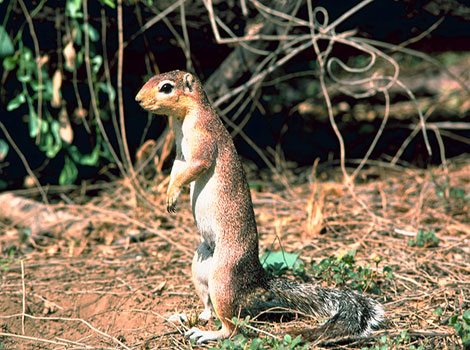
| Attributes | Quick facts |
|---|---|
| Size | 8–10 inches (20–25 cm) |
| Weight | 5–8 oz (140–230 grams) |
| Lifespan | 10–15 years in the wild |
| Habitat | Grasslands and savannas of sub-Saharan Africa |
| Diet | Seeds, fruits, and insects |
| Social Structure | Solitary or small groups |
| Conservation | Least Concern |
Fun Fact: Unstriped Ground Squirrels’ burrows are vital not only for their survival but also provide shelter and cooling for other animals, making them key contributors to arid ecosystems!
19. Utah Prairie Dog
The Utah Prairie Dog (Cynomys parvidens), part of the Sciuridae family, is a small burrowing rodent endemic to southern Utah, USA, particularly in Garfield, Iron, and Kane counties. These prairie dogs thrive in grasslands and shrub-steppe habitats, preferring well-drained soils for burrowing. Measuring 12–14 inches (30–36 cm) in length and weighing 1.5–3 pounds (0.7–1.4 kg), their tan to light brown fur with lighter underparts and black-tipped tails helps them blend into their arid surroundings.
Utah Prairie Dogs are herbivorous, feeding on grasses, seeds, and flowers, and are diurnal, active mainly in the cooler parts of the day. Living in colonies called “coteries,” they share intricate burrow systems and use vocal calls to communicate. Each spring, females give birth to 3–8 pups, caring for them in the burrow until they can venture out independently.
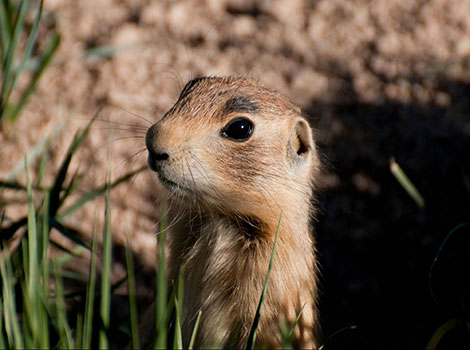
| Attributes | Quick facts |
|---|---|
| Size | 12–15 inches (30–38 cm) |
| Weight | 1–3 lbs (0.5–1.5 kg) |
| Lifespan | 3–5 years in the wild |
| Habitat | Grasslands and plains in Utah, USA |
| Diet | Grasses, seeds, and roots |
| Social Structure | Colonial, living in large family groups |
| Conservation | Near Threatened |
Fun Fact: Listed as threatened, Utah Prairie Dogs are essential to their ecosystem, aerating soil and serving as a key food source for predators like hawks and coyotes!
20. Unadorned Rock Wallaby
The Unadorned Rock Wallaby (Petrogale inornata), a member of the Macropodidae family, is a small marsupial native to northeastern Queensland, Australia. These wallabies thrive in rocky outcrops and boulder-strewn areas within warm, arid to semi-arid climates. Measuring 18–24 inches (45–60 cm) in body length, with a bushy tail of 18–20 inches (45–50 cm), they weigh around 6–11 pounds (3–5 kg). Their soft, grayish-brown fur provides excellent camouflage among rocks.
Adapted for their rugged environment, they possess strong hind legs, padded feet, and sharp claws for leaping and gripping rocks securely. As herbivores, they graze on grasses, shrubs, and leaves, venturing out at dawn or dusk to forage. These wallabies are agile climbers, capable of making long leaps between rocks to evade predators.
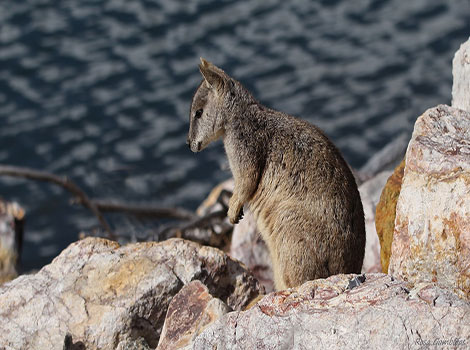
| Attributes | Quick facts |
|---|---|
| Size | 20–24 inches (50–62 cm) |
| Weight | 6–13 lbs (2.7–6 kg) |
| Lifespan | 7–12 years |
| Habitat | Rocky outcrops and cliffs in Queensland, Australia |
| Diet | Grasses, leaves, and shrubs |
| Social Structure | Small groups or solitary |
| Conservation | Near Threatened |
Fun Fact: Female Unadorned Rock Wallabies breed year-round and carry their joey in a pouch for 6–7 months, nurturing them closely even after they leave the pouch!
21. Usambara Shrew
The Usambara Shrew (Crocidura usambarae), a small mammal in the Soricidae family, is endemic to the Usambara Mountains in Tanzania, East Africa. These shrews inhabit the dense undergrowth and leaf litter of montane forests, thriving in the cool, humid climates typical of tropical highlands. They are tiny creatures, measuring 3–4 inches (7.5–10 cm) in length, with a short tail of about 1–1.5 inches (2.5–4 cm) and weighing only 0.3–0.5 ounces (8–14 grams).
Covered in soft, dark gray or brownish fur, they blend seamlessly into their surroundings. Their pointed snout and long whiskers aid in navigating dense forests and locating prey. As insectivores, they hunt insects, spiders, and other invertebrates, relying on a keen sense of smell and touch. Nocturnal and solitary, Usambara Shrews forage energetically to support their high metabolism.
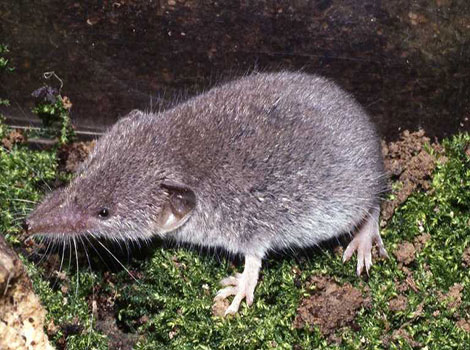
| Attributes | Quick facts |
|---|---|
| Size | ~3–4 inches (7.5–10 cm) |
| Weight | ~1 oz (28 grams) |
| Lifespan | Estimated 1–2 years |
| Habitat | Montane forests of the Usambara Mountains, Tanzania |
| Diet | Insects, worms, and small invertebrates |
| Social Structure | Solitary |
| Conservation | Endangered |
Fun Fact: Despite their tiny size, Usambara Shrews must eat frequently day and night due to their fast metabolism, making them tireless hunters of the forest floor!
After uncovering the fascinating mammals starting with ‘U,’ it’s time to shift our focus to reptiles. These cold-blooded creatures offer a glimpse into a world of remarkable adaptations and survival strategies that set them apart in the animal kingdom.
Reptiles that start with U
Exploring the realm of reptiles, we uncover species starting with the letter ‘U,’ each showcasing unique adaptations and intriguing behaviors that make them stand out in the animal kingdom.
| Uromastyx | Urutu Snake |
22. Uromastyx
The Uromastyx, also known as the Spiny-tailed Lizard, refers to a group of species within the Uromastyx genus, including Uromastyx aegyptia and Uromastyx ornata. These medium to large lizards belong to the Agamidae family and thrive in arid deserts, rocky outcrops, and savannahs across North Africa, the Middle East, and South Asia. They range from 10–14 inches (25–35 cm) in smaller species to up to 30 inches (75 cm) for larger species like the Egyptian Uromastyx, and their weight varies from 8 ounces to 3 pounds (0.2–1.4 kg). Their colors range from earthy browns and grays to vibrant blues, yellows, and greens, depending on the species.
Primarily herbivorous, Uromastyx lizards graze on desert vegetation around dawn and dusk to avoid the intense daytime heat. They are diurnal, spending hours basking in the sun but retreat to burrows for protection. Females lay 10–20 eggs in underground nests, with hatchlings fending for themselves from birth.
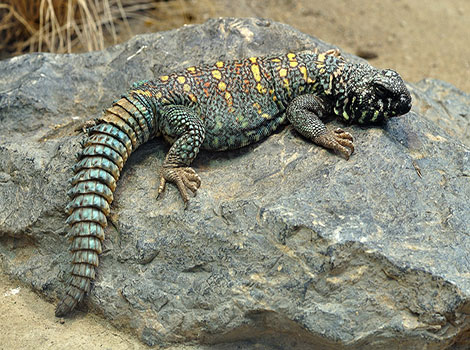
| Attributes | Quick facts |
|---|---|
| Size | 10–36 inches (25–91 cm) |
| Weight | 1–3 lbs (0.5–1.4 kg) |
| Lifespan | 15–20 years |
| Habitat | Arid deserts and rocky regions of North Africa, the Middle East, and South Asia |
| Diet | Leaves, seeds, flowers, and fruits (herbivorous) |
| Social Structure | Solitary or small groups |
| Conservation | Least Concern |
Fun fact: Uromastyx can inflate their bodies to wedge into crevices, making it nearly impossible for predators to remove them!
23. Urutu Snake
The Urutu Snake, or Lancehead Viper (Bothrops alternatus), is a venomous snake from the Viperidae family. Native to South America, it inhabits lowland tropical forests, savannas, grasslands, and marshes in countries like Brazil, Paraguay, Argentina, and Uruguay. These snakes prefer warm, humid climates near water sources and are non-migratory, though they may move short distances for food or seasonal changes. They measure 4–6 feet (1.2–1.8 meters) in length and weigh 6–10 pounds (2.7–4.5 kilograms). Their dark brown or gray bodies are patterned with triangular or diamond-shaped markings, providing excellent camouflage.
Urutu Snakes are ambush predators, using heat-sensing pits to locate prey like rodents, birds, amphibians, and small reptiles. They are primarily nocturnal and crepuscular, hiding under leaves or logs during the day. As ovoviviparous reptiles, they give birth to live young that are fully independent from birth.
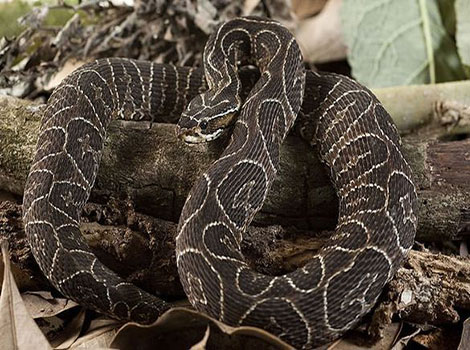
| Attributes | Quick facts |
|---|---|
| Size | 4–6 feet (1.2–1.8 meters) |
| Weight | 6–10 lbs (2.7–4.5 kg) |
| Lifespan | 10–20 years |
| Habitat | Forests, grasslands, and wetlands in South America |
| Diet | Small mammals, birds, and reptiles |
| Social Structure | Solitary |
| Conservation | Least Concern |
Fun fact: The Urutu Snake’s venom, while potent, has been researched for potential medicinal uses, such as treating blood clotting disorders!
Moving on from reptiles, we now take to the skies to explore birds that start with ‘U.’ These feathered creatures captivate with their unique traits and behaviors, showcasing the beauty and diversity of the avian world.
Birds that start with U
Birds starting with ‘U’ boast unique traits and fascinating behaviors, showcasing the incredible diversity of the avian world.
| Ural Owl | Upland Sandpiper | Upupa |
| Uluguru Violet-Backed Sunbird | Upland Goose | Uguisu |
| Umbrella Cockatoo |
24. Ural Owl
The Ural Owl (Strix uralensis) is a medium-to-large owl found in boreal forests, mixed woodlands, and mountainous regions across Europe, Russia, and parts of Asia. It prefers cold to temperate climates, often inhabiting areas with dense forests and clearings. Measuring 19–24 inches (50–62 cm) in length with a wingspan of 3.5–4 feet (104–125 cm), it weighs between 1.5–2.5 pounds (0.7–1.2 kg). Its pale gray or brownish-gray plumage is streaked, and its round head features a pale facial disk bordered by dark markings, large dark eyes, and no ear tufts.
The Ural Owl hunts primarily at night, targeting small mammals, birds, and insects. It perches silently to locate prey before swooping down. Solitary and territorial, it vigorously defends its nesting and hunting areas. Breeding occurs in late winter, with females laying 2–4 eggs in tree cavities. Both parents care for the chicks until they fledge at about 4–6 weeks.
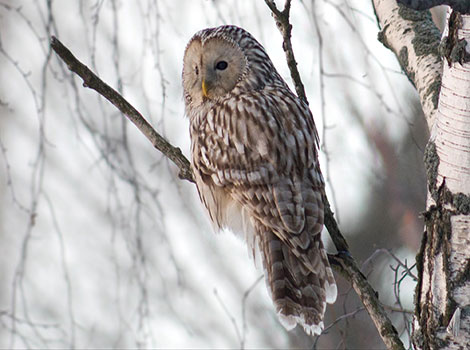
| Attributes | Quick facts |
|---|---|
| Size | 19–24 inches (50–62 cm) |
| Weight | 1.5–2.6 lbs (700–1,200 grams) |
| Lifespan | 15–20 years |
| Habitat | Boreal forests and mixed woodlands of Europe and Asia |
| Diet | Small mammals, birds, and insects |
| Social Structure | Solitary, pairs during breeding |
| Conservation | Least Concern |
Fun fact: The Ural Owl is famously fearless in defending its nest, even attacking humans if it perceives a threat!
25. Upland Sandpiper
The Upland Sandpiper (Bartramia longicauda) is a medium-sized shorebird from the Scolopacidae family. Found in North America’s grasslands, prairies, and pastures during breeding season, it migrates to South America in winter, favoring tropical climates in Argentina, Uruguay, and Paraguay. Measuring 10.5–12.5 inches (27–32 cm) long with a wingspan of 18–21 inches (46–53 cm), it weighs 4–7 ounces (113–198 grams). Its mottled brown and black upperparts, pale underparts, long neck, and small head give it a distinctive appearance, along with its slim body and graceful, buoyant flight.
Feeding primarily on insects like grasshoppers, crickets, and beetles, the Upland Sandpiper forages by walking through grasses. It breeds in early summer, laying 4 eggs in ground nests hidden in grass clumps. Both parents care for the chicks, which are precocial and can forage shortly after hatching.
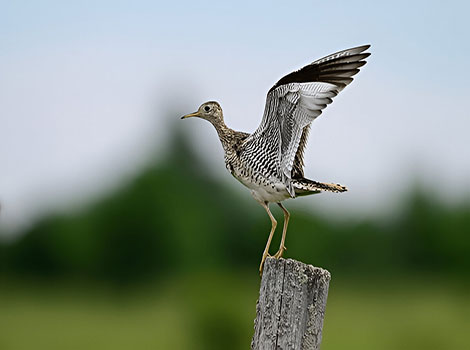
| Attributes | Quick facts |
|---|---|
| Size | 10–12 inches (25–30 cm) |
| Weight | 4–8 oz (120–230 grams) |
| Lifespan | 5–7 years |
| Habitat | Grasslands, prairies, and open fields in North America |
| Diet | Insects and seeds |
| Social Structure | Solitary or small groups |
| Conservation | Least Concern |
Fun fact: Unlike most sandpipers, the Upland Sandpiper thrives in dry grasslands, earning it the nickname “prairie sandpiper”!
26. Upupa
Hoopoe (Upupa epops) is a medium-sized bird belonging to the family Upupidae. Known for its striking cinnamon-orange plumage and black-and-white striped wings and tail, it measures 10–12.6 inches (25–32 cm) in length with a wingspan of 17–19 inches (44–48 cm) and weighs 1.6–3.1 ounces (47–87 grams). Its slim body, long, curved beak, and distinctive crest of feathers, which fans out like a crown, make it easily recognizable. Hoopoes inhabit open landscapes like savannas, grasslands, orchards, and farmlands across Europe, Asia, and Africa. While northern populations migrate in winter, tropical ones remain sedentary.
These birds are diurnal and forage on the ground, using their long beaks to probe soil or tree bark for insects, larvae, small reptiles, and seeds. Hoopoes nest in cavities, laying 5–7 eggs. Both parents care for their chicks, which fledge 26–29 days after hatching.
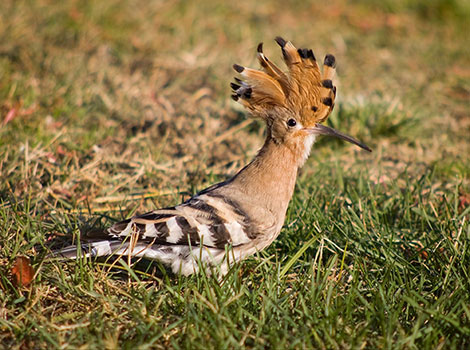
| Attributes | Quick facts |
|---|---|
| Size | 10–12 inches (25–32 cm) |
| Weight | 1.6–3.1 oz (45–87 grams) |
| Lifespan | 10 years |
| Habitat | Open woodlands, savannas, and grasslands across Europe, Asia, and Africa |
| Diet | Insects, small reptiles, and seeds |
| Social Structure | Solitary or pairs |
| Conservation | Least Concern |
Fun fact: The Hoopoe’s repetitive “hoo-poo-poo” call inspired its name, and in ancient folklore, it symbolized virtue and protection.
27. Uluguru Violet-Backed Sunbird
The Uluguru Violet-Backed Sunbird (Anthreptes neglectus) is a small, colorful bird endemic to the Uluguru Mountains in Tanzania. Measuring 3.9–4.7 inches (10–12 cm) in length and weighing only 0.2–0.3 ounces (6–9 grams), this slender-bodied sunbird thrives in subtropical or tropical moist lowland forests and forest edges. Males boast a metallic violet back, greenish or yellow belly, and dark wings, while females have subtler olive-green or yellowish plumage. Their slightly curved beaks are perfectly adapted for sipping nectar from flowers in the warm, humid climates they inhabit.
Active during the day, these birds forage for nectar, insects, and spiders, often seen in pairs or small groups defending flowering plants. Females build hanging, dome-shaped nests and lay 1–2 eggs, incubating them for 14–16 days. The chicks fledge about 2–3 weeks after hatching, primarily cared for by the female.
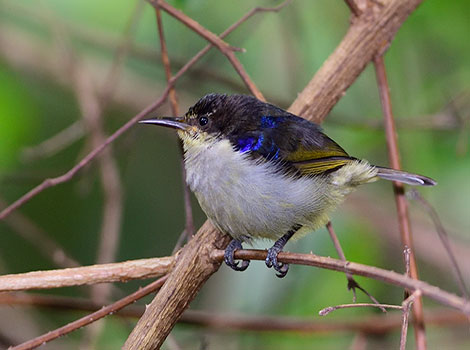
| Attributes | Quick facts |
|---|---|
| Size | ~4 inches (10 cm) |
| Weight | ~0.3 oz (8–10 grams) |
| Lifespan | Estimated 5–7 years |
| Habitat | Forests of the Uluguru Mountains, Tanzania |
| Diet | Nectar, insects, and spiders |
| Social Structure | Solitary or small groups |
| Conservation | Least Concern |
Fun fact: Uluguru Violet-Backed Sunbirds are vital pollinators, transferring pollen between flowers as they feed on nectar!
28. Upland Goose
The Upland Goose (Chloephaga picta) is a medium-sized bird from the Anatidae family, native to southern South America, including Argentina, Chile, and the Falkland Islands. It inhabits open grasslands, shrublands, and agricultural areas near water, thriving in temperate and sub-Antarctic climates. Measuring 24–30 inches (61–76 cm) in length with a wingspan of 50–60 inches (127–152 cm), these geese weigh 4–8 pounds (1.8–3.6 kg). Males have white heads and chests with black-barred underparts, while females are brown with dark barring for camouflage.
Primarily terrestrial, Upland Geese graze on grasses, seeds, and leaves. They are diurnal and social, often found in pairs or small flocks, though territorial during breeding. Females lay 4–8 eggs in ground nests, with both parents guarding the precocial goslings, which begin grazing shortly after hatching.
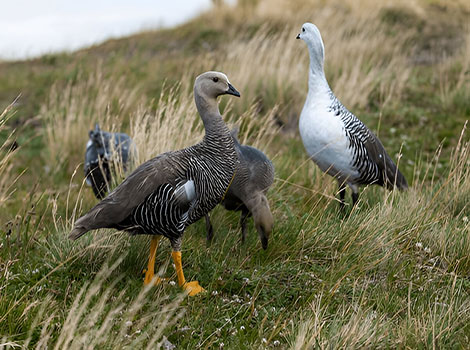
| Attributes | Quick facts |
|---|---|
| Size | 24–30 inches (60–76 cm) |
| Weight | 6–9 lbs (2.7–4 kg) |
| Lifespan | 10–20 years |
| Habitat | Grasslands and open plains in southern South America |
| Diet | Grasses, seeds, and leaves |
| Social Structure | Monogamous pairs or small flocks |
| Conservation | Least Concern |
Fun fact: During their molting period, Upland Geese are flightless, relying on their excellent camouflage to avoid predators!
29. Uguisu
The Japanese Bush Warbler, or Uguisu (Horornis diphone), is a small bird in the Cettiidae family, native to Japan, Korea, Taiwan, and parts of eastern China. Preferring temperate and subtropical climates, it inhabits forests, bamboo thickets, and dense shrublands. Measuring 5.5–6 inches (14–15 cm) in length and weighing 0.4–0.6 ounces (11–18 grams), it has dull brownish-green upperparts and pale underparts, blending seamlessly into its environment. Its compact body and slightly curved beak are well-suited for its insectivorous diet.
This diurnal bird spends its days hidden in dense vegetation, foraging for insects, spiders, and berries. During spring, females build cup-shaped nests in shrubs, laying 2–5 eggs. After 13–15 days of incubation, the chicks hatch and are cared for by the female until they fledge 10–12 days later.
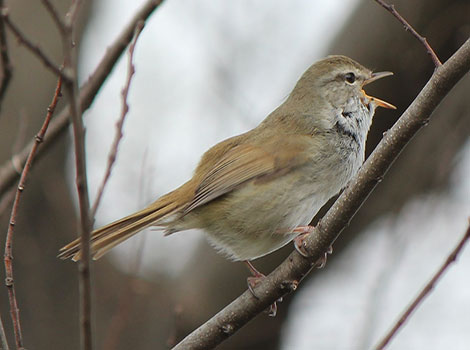
| Attributes | Quick facts |
|---|---|
| Size | 5–6 inches (13–15 cm) |
| Weight | ~0.4 oz (10–12 grams) |
| Lifespan | Estimated 2–5 years |
| Habitat | Forests, bamboo thickets, and gardens in East Asia |
| Diet | Insects, larvae, and berries |
| Social Structure | Solitary or in pairs during breeding season |
| Conservation | Least Concern |
Fun fact: Known as the “Japanese Nightingale,” the Uguisu’s melodious springtime song is celebrated in Japanese culture and poetry!
30. Umbrella Cockatoo
The Umbrella Cockatoo, or White Cockatoo (Cacatua alba), is a medium-sized parrot native to the tropical rainforests, mangroves, and lowland forests of Indonesia’s Maluku Islands. These birds thrive in warm, humid climates and are non-migratory, though they may roam locally for food. Measuring 18–20 inches (45–50 cm) in length and weighing 14–20 ounces (400–600 g), they have predominantly white feathers with a yellowish tint under their wings and tail. Their most striking feature is their large, fan-shaped crest that resembles an umbrella when raised.
Umbrella Cockatoos are diurnal and spend their days foraging for seeds, nuts, fruits, berries, and insects, often in flocks. They are monogamous, breeding once a year and laying 2–3 eggs in tree hollows. Both parents share incubation duties and care for the chicks until they fledge and remain with the family for some time.
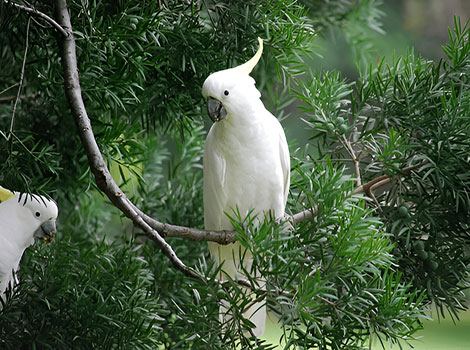
| Attributes | Quick facts |
|---|---|
| Size | 17–18 inches (43–46 cm) |
| Weight | 14–20 oz (400–600 grams) |
| Lifespan | 40–60 years |
| Habitat | Tropical rainforests of Indonesia and surrounding islands |
| Diet | Fruits, seeds, nuts, and insects |
| Social Structure | Social, often found in pairs or flocks |
| Conservation | Vulnerable |
Fun fact: Renowned for their intelligence and affection, Umbrella Cockatoos make popular pets, but their sharp minds require plenty of mental stimulation to keep them happy and healthy!
Leaving the skies behind, we now dive into the aquatic realm to discover fish that start with ‘U.’ These fascinating creatures highlight the remarkable adaptations and diversity found beneath the water’s surface.
Fish that start with U
The underwater world thrives with diversity, and fish starting with ‘U’ bring unique features and intriguing behaviors to light.
| Upland Bully | Uaru Cichlid |
31. Upland Bully
The Upland Bully (Gobiomorphus breviceps) is a small freshwater fish endemic to New Zealand, found in clean, fast-flowing streams, rivers, and lakes in upland areas. Thriving in temperate climates, it prefers cool, oxygen-rich waters and remains non-migratory within freshwater systems. Measuring just 2.4–3.5 inches (6–9 cm) and weighing less than 0.5 ounces (10–15 grams), its brown to olive-green body is mottled with dark patterns, providing excellent camouflage among rocky substrates.
This bottom-dweller feeds on aquatic invertebrates like insects, crustaceans, and mollusks, foraging near the streambed and using vegetation for cover. Active during twilight hours, it spawns in spring and summer when males establish territories and guard eggs laid by females on submerged surfaces. The males ensure oxygenation by fanning the eggs until they hatch.
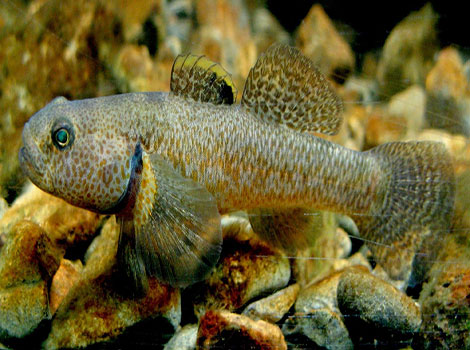
| Attributes | Quick facts |
|---|---|
| Size | ~4–6 inches (10–15 cm) |
| Weight | ~1–2 oz (30–60 grams) |
| Lifespan | Estimated 3–5 years |
| Habitat | Freshwater rivers and streams in New Zealand |
| Diet | Aquatic invertebrates and small crustaceans |
| Social Structure | Solitary |
| Conservation | Least Concern |
Fun fact: The Upland Bully is one of New Zealand’s few native freshwater fish species, playing a crucial role in its aquatic ecosystems!
32. Uaru Cichlid
The Uaru Cichlid (Uaru amphiacanthoides), also known as the Triangle Cichlid, is a large, oval-shaped freshwater fish native to the Amazon Basin in South America, including Brazil, Venezuela, and Colombia. Found in slow-moving rivers and floodplains with dense vegetation, it thrives in warm, slightly acidic tropical waters (pH 5.5–7.0). These fish grow up to 10–12 inches (25–30 cm) long and weigh about 1.5–2 pounds (0.7–0.9 kg). Their olive-green to brown bodies feature a dark triangular patch on each side, and juveniles display white spots.
Omnivorous by nature, Uaru Cichlids graze on algae, plant matter, fruits, and small invertebrates, contributing to their ecosystem’s balance. Social and diurnal, they are often seen in pairs or small groups, actively foraging and defending territories. During breeding, they form monogamous pairs, laying eggs on flat surfaces and fiercely guarding their offspring. Parents also feed their fry with mucus secretions from their skin.
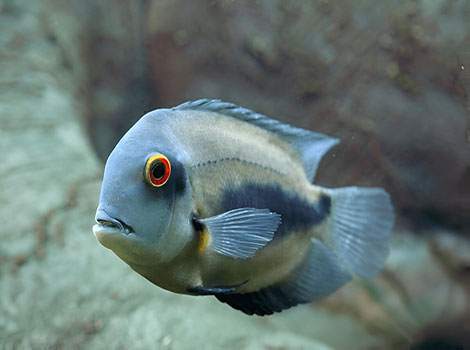
| Attributes | Quick facts |
|---|---|
| Size | 8–14 inches (20–36 cm) |
| Weight | 0.5–2 lbs (0.2–0.9 kg) |
| Lifespan | 7–10 years |
| Habitat | Lakes, ponds, and slow-moving rivers in the western United States |
| Diet | Insects, algae, and small aquatic organisms |
| Social Structure | Schooling fish |
| Conservation | Least Concern |
Fun fact: Nicknamed the “poor man’s discus,” the Uaru Cichlid resembles the discus in shape and beauty but is much hardier and easier to care for in aquariums!
From the depths of the water, we turn our attention to the world of insects starting with ‘U.’ These small yet remarkable creatures reveal fascinating adaptations and play vital roles in their ecosystems.
Insects that start with U
Insects beginning with ‘U’ showcase remarkable adaptations and intriguing traits, adding to the endless fascination of the insect world.
33. Ulysses Butterfly
The Ulysses Butterfly (Papilio ulysses), also known as the Blue Mountain Butterfly, is a stunning swallowtail native to northern Australia, Papua New Guinea, Indonesia, and the Solomon Islands. Preferring warm, humid tropical and subtropical climates, it inhabits rainforests, forest edges, and gardens. With a wingspan of 4.5–5.5 inches (11–14 cm), its upper wings shine an iridescent blue bordered with black, while the underside is brown with subtle patterns for camouflage. This brilliant blue is caused by structural coloration, reflecting specific light wavelengths.
Active during sunny periods, the Ulysses Butterfly flutters swiftly and erratically, feeding on nectar from flowers like Euodia and Mussaenda. Females lay tiny eggs singly on the leaves of host plants, such as citrus trees. The larvae feed on the host plant until they pupate, with no parental care involved.
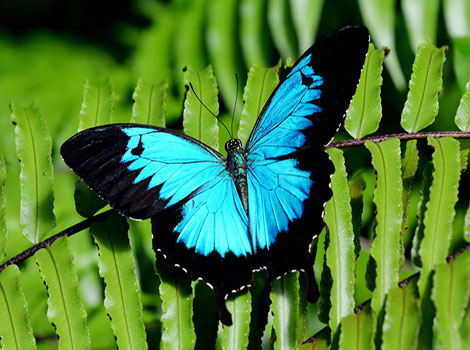
| Attributes | Quick facts |
|---|---|
| Size | Wingspan 4.7–5.5 inches (12–14 cm) |
| Weight | A few grams |
| Lifespan | 3–4 weeks |
| Habitat | Rainforests and coastal woodlands in Australia and Papua New Guinea |
| Diet | Nectar from flowers |
| Social Structure | Solitary |
| Conservation | Least Concern |
Fun fact: The Ulysses Butterfly is an emblem of Queensland, Australia, celebrated for its vibrant blue color and iconic beauty, beloved by photographers and butterfly enthusiasts alike!
Leaving insects behind, we now explore other animals that start with ‘U,’ showcasing unique species from various categories that further highlight the diversity of life on Earth.
Other animals that start with U
Animals starting with ‘U’ from various categories display fascinating traits, reflecting the incredible diversity of life on Earth.
34. Urechis unicinctus (Penis Fish)
The Penis Fish, or Fat Innkeeper Worm (Urechis unicinctus), is a medium-sized marine worm from the Urechidae family. Native to East Asia, it inhabits mudflats, sandy shores, and shallow marine environments in temperate coastal waters of China, Korea, and Japan. Measuring 6–10 inches (15–25 cm) in length and weighing 0.2–0.4 pounds (90–180 grams), its pale pink, sausage-shaped body is smooth and cylindrical, tapering slightly at one end. Unlike segmented worms, it creates U-shaped burrows in sand or mud.
A filter feeder, the Penis Fish secretes a mucus net in its burrow to trap plankton and organic matter from the water, which it consumes. Sedentary by nature, it plays a vital ecological role by aerating sediments and recycling nutrients. Reproduction involves external spawning, with gametes released into the water column for fertilization. Larvae develop planktonically before settling into burrows.
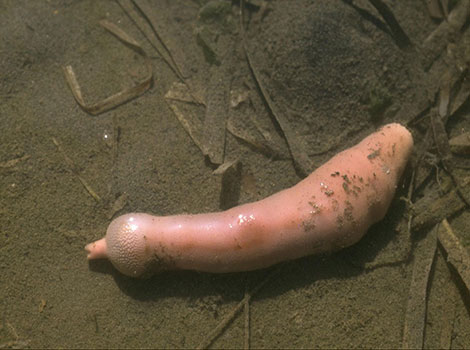
| Attributes | Quick facts |
|---|---|
| Size | 6–10 inches (15–25 cm) |
| Weight | ~1–2 lbs (0.5–1 kg) |
| Lifespan | Up to 25 years |
| Habitat | Muddy or sandy seafloors in shallow coastal waters of East Asia |
| Diet | Plankton and organic matter |
| Social Structure | Lives in burrows, often in colonies |
| Conservation | Not Evaluated |
Fun fact: The Penis Fish’s burrows often house other marine creatures like crabs and shrimp, earning it the nickname “innkeeper worm”!
FAQs
What Zoo Animals that Start with U?
Here are the top 5 Zoo Animals start with U:
- Uromastyx (Uromastyx spp.): Uromastyx lizards are medium to large-sized and are known for their spiky appearance. They have a robust body with spiny scales and a flattened tail. Uromastyx lizards are primarily found in arid and semi-arid regions of North Africa, the Middle East, and South Asia. These lizards have a unique adaptation to their harsh desert habitats, and they are herbivorous, feeding on a diet of plants.
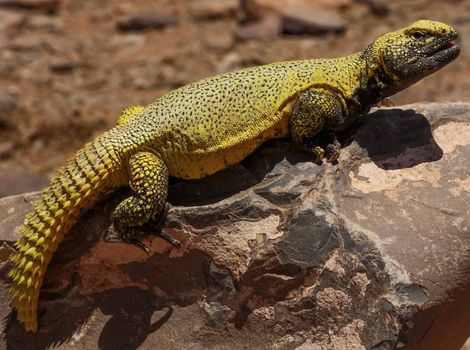
- Urial (Ovis vignei): Urials are wild sheep found in central Asia. They are mammals and belong to the Bovidae family. Urials have distinctive curved horns and are adapted to mountainous habitats. Their fur is usually brown or grayish, providing camouflage in their rocky terrain.
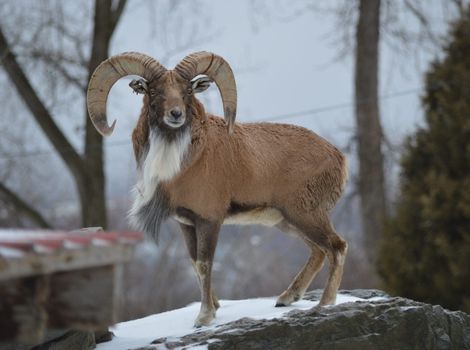
- Unicorn Tang (Naso unicornis): The Unicorn Tang (Naso unicornis) is a type of surgeonfish found in the warm waters of the Indo-Pacific region. It is a marine fish and belongs to the Acanthuridae family. The Unicorn Tang gets its name from the horn-like extension on its forehead, which is elongated and pointed. These fish are known for their vibrant blue bodies and unique facial features, making them popular inhabitants of saltwater aquariums.
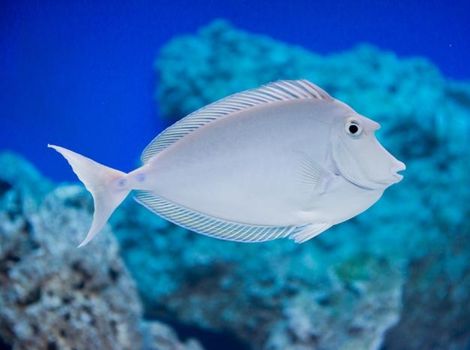
- Umbrella Cockatoo (Cacatua alba): The Umbrella Cockatoo is a medium-sized parrot known for its striking appearance. These birds are predominantly white, with a distinctive crest of feathers on their heads that they can raise like an umbrella, hence their name. Umbrella Cockatoos are native to the tropical rainforests of Indonesia and nearby regions. They are social birds, highly intelligent, and can be trained to mimic sounds and perform tricks.
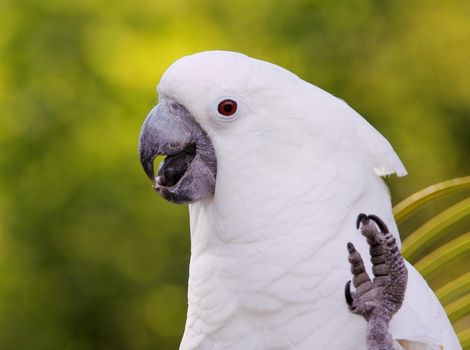
- Uinta Ground Squirrel (Urocitellus armatus): Uinta Ground Squirrels are small rodents found in North America, specifically in the western United States. They belong to the Sciuridae family and are known for their burrowing habits. These ground squirrels have a sandy-brown coat with a white stripe on their sides. They hibernate during the winter months and are diurnal, meaning they are active during the daytime.
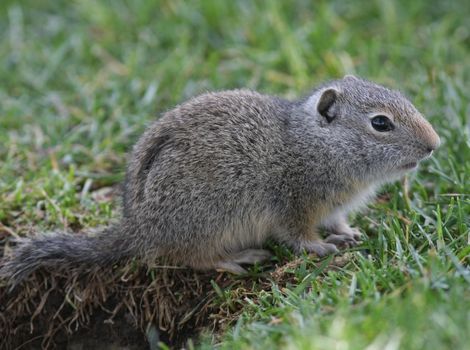
What Animals in Africa that Start with U?
Here are the Top 5 popular animals in Africa that start with U:
- Uakari Monkey (Cacajao): Some species of Uakaris, such as the Bald Uakari (Cacajao calvus), can be found in the Amazon rainforests of Africa’s western neighbor, Brazil.
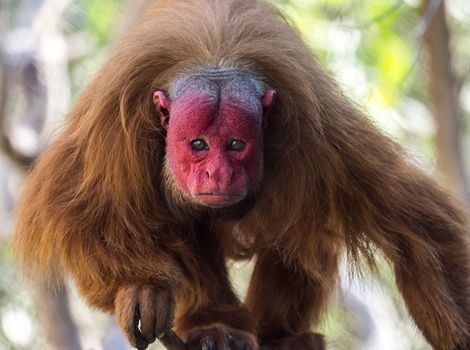
- Upemba Golden Frog (Sclerophrys channingi): The Upemba Golden Frog is a species of frog native to the Upemba National Park in the Democratic Republic of the Congo. These frogs are small and brightly colored, with golden or yellow skin and distinctive black markings. They are part of the Bufonidae family and are known for their vibrant appearance. However, they are also critically endangered due to habitat loss and chytrid fungus.
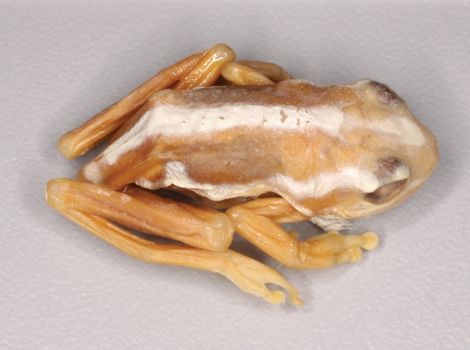
- Uganda Clawed Frog (Xenopus ruwenzoriensis): The Uganda Clawed Frog is a species of aquatic frog found in Uganda and Rwanda. These amphibians belong to the Pipidae family and are characterized by their flattened bodies and webbed feet with distinct claws. They are adapted to a semi-aquatic lifestyle and can often be found in ponds, swamps, and slow-moving rivers.
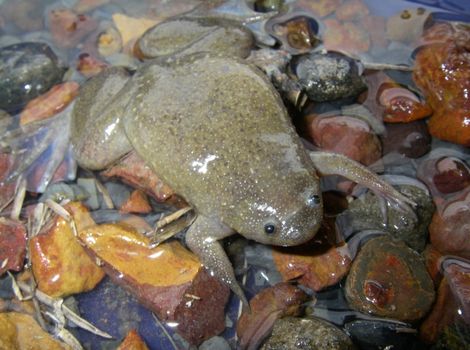
- Unstriped Ground Squirrel (Xerus rutilus): The Unstriped Ground Squirrel is a small rodent species native to parts of eastern and southern Africa, including Tanzania, Kenya, and Zambia. These ground squirrels have reddish-brown to grayish-brown fur and lack the typical stripes seen in some other squirrel species. They are diurnal and burrowing animals, often inhabiting savannas and grasslands.
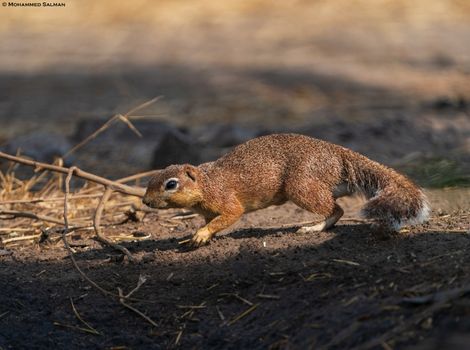
- Uroplatus Gecko (Uroplatus spp.): The Uroplatus Gecko is a group of reptiles found in Madagascar and nearby islands. These geckos are known for their exceptional camouflage abilities, resembling pieces of bark or leaves. They are part of the Gekkonidae family and are primarily arboreal, inhabiting forests and tropical environments. Uroplatus Geckos have specialized toe pads that allow them to cling to vertical surfaces, making them skilled climbers.
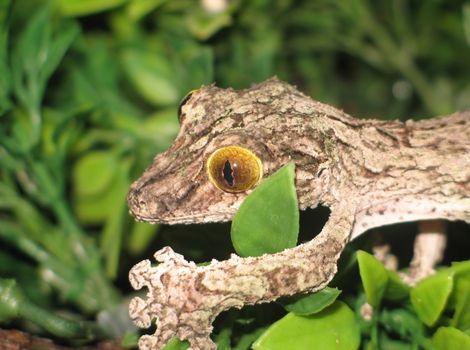
What Big Animals that Start with U?
Here are the Top 5 big animals that start with U:
- Ural Owl (Strix uralensis): The Ural Owl is a large bird of prey belonging to the Strigidae family. These owls have substantial bodies, with a wingspan that can exceed 2 feet (60 centimeters). They are known for their dense, mottled brown plumage and striking dark eyes. Ural Owls inhabit forests across Europe and Asia, often nesting in tree cavities. Their outstanding feature is their ability to hunt in low light conditions, making them effective nocturnal hunters.
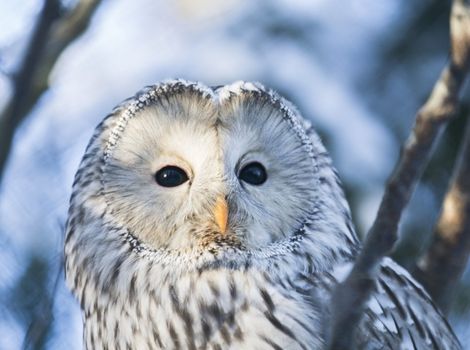
- Unicornfish (Naso spp.): Unicornfish are sizeable marine fish belonging to the Acanthuridae family. They can grow up to 2 feet (60 centimeters) in length and are characterized by their elongated bodies and a prominent horn-like projection on their foreheads. These fish are found in tropical and subtropical waters of the Indo-Pacific region, typically near coral reefs and rocky areas. Their distinctive appearance and graceful swimming make them popular additions to marine aquariums.
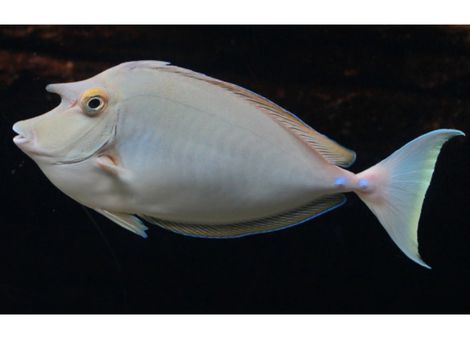
- Upemba Labeo (Labeo upembae): The Upemba Labeo is a large freshwater fish native to the Upemba National Park in the Democratic Republic of the Congo. These fish can reach substantial sizes, with some individuals exceeding 12 inches (30 centimeters) in length. They are part of the Cyprinidae family and are known for their streamlined bodies and silver coloration. Upemba Labeos inhabit slow-moving rivers and lakes within their range.
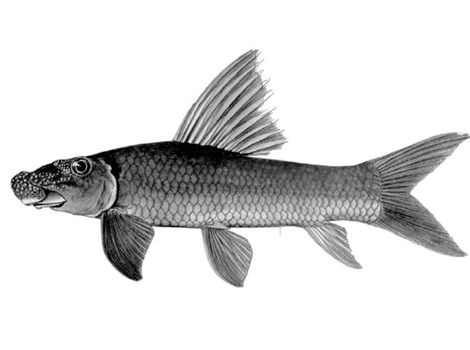
- Uganda Kob (Kobus kob thomasi): The Uganda Kob is a large antelope species found in eastern Africa, including Uganda and Sudan. These herbivores are known for their sizable bodies, with males weighing up to 220 pounds (100 kilograms) and sporting impressive spiral horns. Uganda Kobs have reddish-brown fur and distinctive white patches on their legs and face. They primarily inhabit savannas, grasslands, and floodplains.
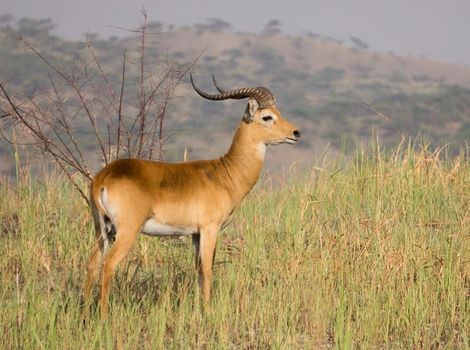
- Utahraptor (Utahraptor ostrommaysorum): Utahraptor is an extinct dinosaur species that lived during the Early Cretaceous period. These dinosaurs were part of the theropod family and were known for their substantial size, with some individuals estimated to be up to 20 feet (6 meters) in length. Utahraptors were carnivorous predators with sharp claws and teeth, making them formidable hunters. They walked on two legs and were among the largest raptors to have existed.
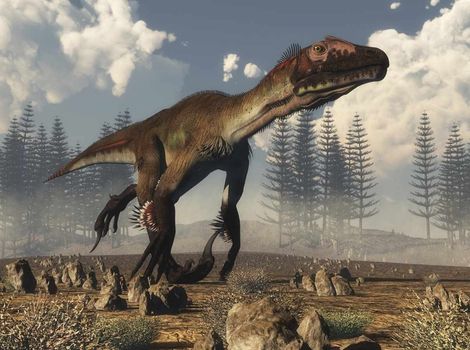
What Endangered Animals that Start with U?
Here are the Top 3 endangered animals that start with U:
- Uzbekistan Markhor (Capra falconeri heptneri): Markhors are large wild goats known for their twisted horns and shaggy coats. The Uzbekistan markhor is a subspecies of markhor found in Central Asia. They inhabit rugged mountainous regions in Uzbekistan and neighboring countries. Outstanding Features: The distinctive corkscrew-shaped horns of the markhor make them stand out. They are endangered due to habitat loss and poaching for their horns.
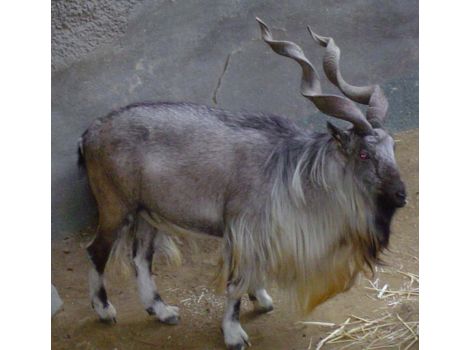
- Uttarakhand False Vampire Bat (Megaderma spasma): The Uttarakhand false vampire bat is a bat species with a wingspan of about 30 cm. They have large ears and a distinctive facial structure. They are found in forested areas and caves in parts of Asia, including Uttarakhand, India. These bats are known for their unusual feeding behavior as they primarily consume insects, including moths and beetles. They face threats from habitat destruction and disturbance of their roosting sites.
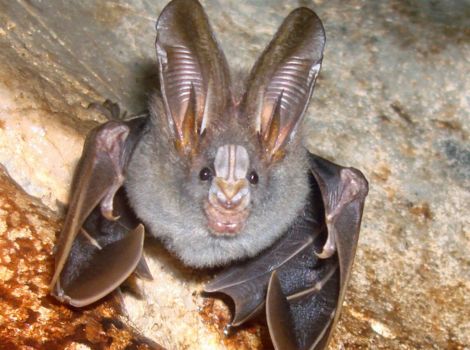
- Udzungwa Red Colobus (Procolobus gordonorum): Udzungwa red colobus are primates with red fur on their back and limbs and a black face. They have a prehensile tail. They are found in the Udzungwa Mountains of Tanzania, East Africa. These colobus monkeys are known for their restricted habitat range and unique coloration. They are endangered due to habitat loss and fragmentation.
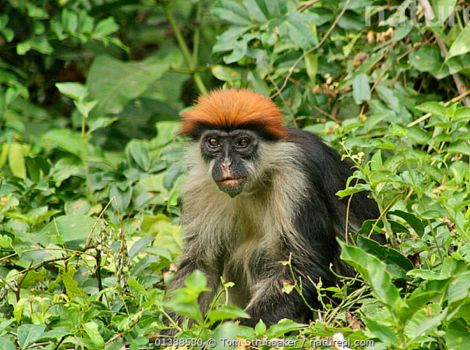
What Farm Animals that Start with U?
Here are the Top 5 popular animals that start with U:
- Udder (Bos taurus): The udder is not a distinct animal but rather a specific anatomical part of female cattle, goats, and sheep. It is the mammary gland structure from which milk is produced and extracted. Udders are found on dairy cows, goats, and sheep raised on farms around the world. The udder plays a vital role in milk production, providing nutrition for both livestock and humans. Dairy animals are specifically bred for their milk-producing abilities, and the udder is a key feature in evaluating their potential.
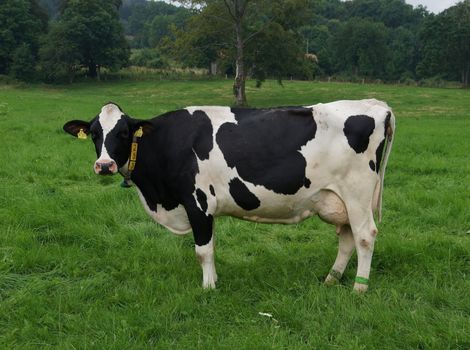
- Upland Goose (Chloephaga picta): Upland geese are waterfowl with a distinct appearance, including a white face, dark neck, and grayish-brown body. Males and females often have slightly different plumage. They are found in the upland and highland regions of South America, particularly in the Andes mountains. While not traditional farm animals, upland geese are occasionally kept on farms for their ornamental value and as waterfowl for hunting. They are known for their adaptability to different altitudes and are often seen near freshwater lakes.
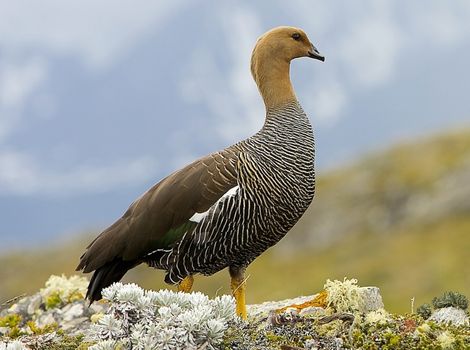
- Urutu (Bothrops alternatus): The urutu (Argentine Lancehead) is a venomous pit viper snake with a relatively robust body and a patterned appearance, including dark bands. They are found in parts of South America, including Argentina, Brazil, and Uruguay, in various habitats such as grasslands and forests. Urutus are not farm animals but rather a snake species that can occasionally be encountered on farms. They are important in the ecosystem as both predators and prey.
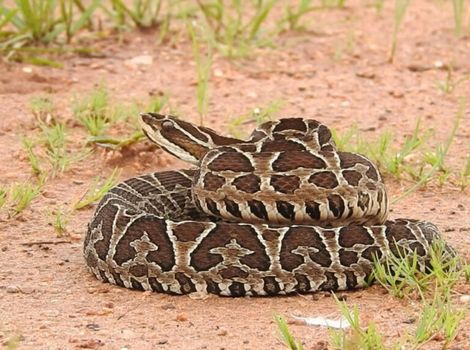
- Uzbek Sheep (Ovis aries):Uzbek sheep are a domesticated breed of sheep that originated in Uzbekistan. They have a distinctive appearance with a white fleece and sometimes exhibit a unique fat-tailed trait. They are commonly raised on farms in Uzbekistan and other parts of Central Asia for their wool, meat, and milk production. The Uzbek sheep are known for their adaptation to arid and semi-arid regions and are prized for their wool quality.
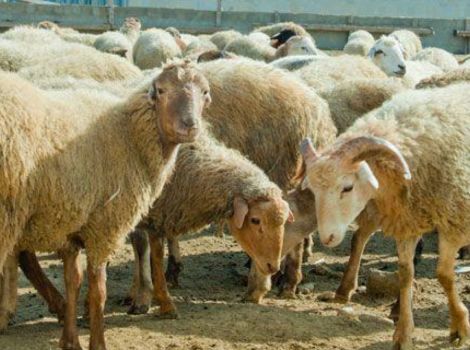
- Umbrella Chicken (Gallus gallus domesticus): “Umbrella chicken” is a term that is sometimes used colloquially to describe certain chickens with unique feather patterns that resemble an open umbrella. Chickens, including those with umbrella-like feather patterns, are commonly raised on poultry farms worldwide for meat and egg production. While “umbrella chicken” may not refer to a specific breed, it highlights the diversity of chicken breeds on farms.
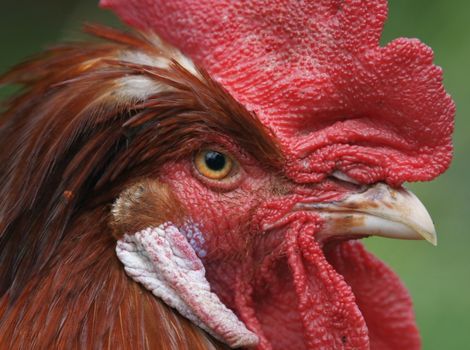
What Animal’s name ends with U?
Here are the Top 5 interesting animal’s name ends with U:
- Emu (Dromaius novaehollandiae): The emu is the largest flightless bird native to Australia. They have a tall, slender body covered in brown feathers, a long neck, and strong legs. Emus are found in various habitats, including forests, grasslands, and semi-arid areas. Emus are known for their speed and endurance, capable of running at speeds of up to 50 km/h (30 mph) and traveling long distances in search of food.

- Caribou (Rangifer tarandus): Also known as reindeer in Eurasia, are large herbivorous mammals known for their impressive antlers and adaptability to cold environments. They are found in northern regions, including tundra, boreal forests, and subarctic areas in North America, Europe, and Asia. Caribou are known for their long migrations, where they travel vast distances to find food and escape harsh winter conditions. Their antlers are a symbol of their species, with both males and some females growing them.
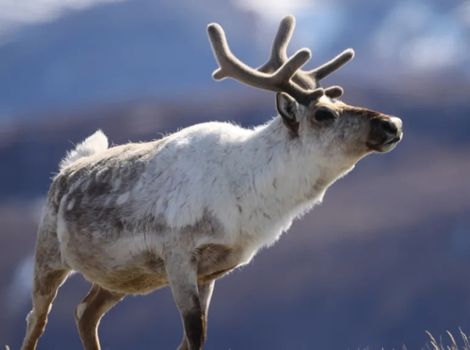
- Kinkajou (Potos flavus): The kinkajou is a tropical rainforest mammal related to raccoons. They have prehensile tails, long tongues, and round faces. They are found in the rainforests of Central and South America. Kinkajous are primarily nocturnal and have a sweet tooth, often feeding on nectar and fruit.
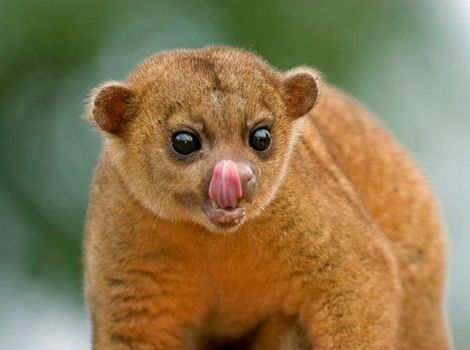
- Puku (Kobus vardonii): The puku is a medium-sized antelope with a reddish-brown coat and distinctive V-shaped white markings on its face. They inhabit wetlands and grasslands in Zambia and surrounding regions. Pukus are known for their agility and excellent swimming abilities, often found near water sources.
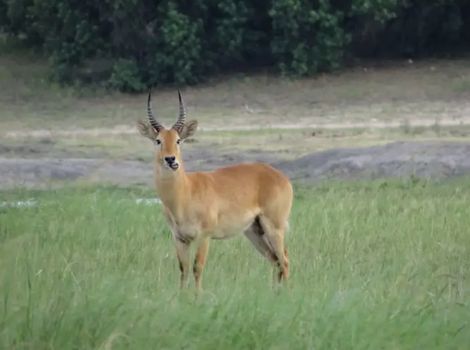
- Hoopoe (Upupa epops): The hoopoe is a distinctive bird with a long, curved bill, a crown of feathers that can be raised into a crest, and a brown and white striped plumage. They are found in various habitats across Eurasia, Africa, and the Indian subcontinent. Hoopoes are known for their unique appearance and their melodious call. They are often associated with good luck in some cultures.
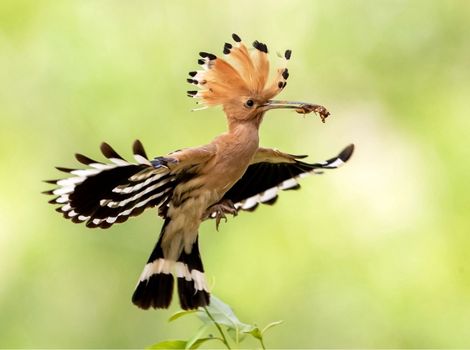
From mammals to birds, reptiles to insects, the animals starting with ‘U’ showcase the remarkable diversity and wonder of the natural world. Each species, with its unique traits and behaviors, reminds us of the endless marvels waiting to be explored. Whether you’re learning for fun or fueling your curiosity, this collection of creatures proves there’s always something new to discover in nature!
If you’re searching for animal names starting with a different letter, explore our other comprehensive articles dedicated to animal names.
